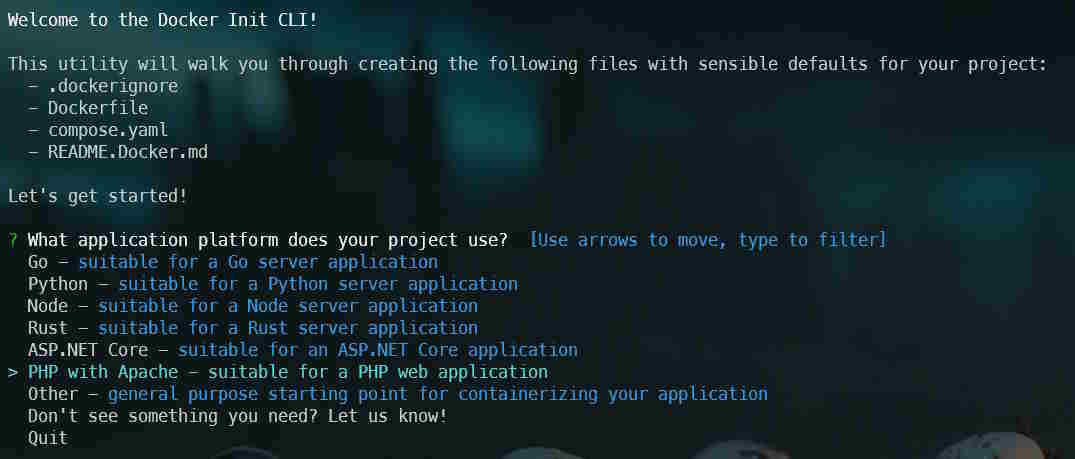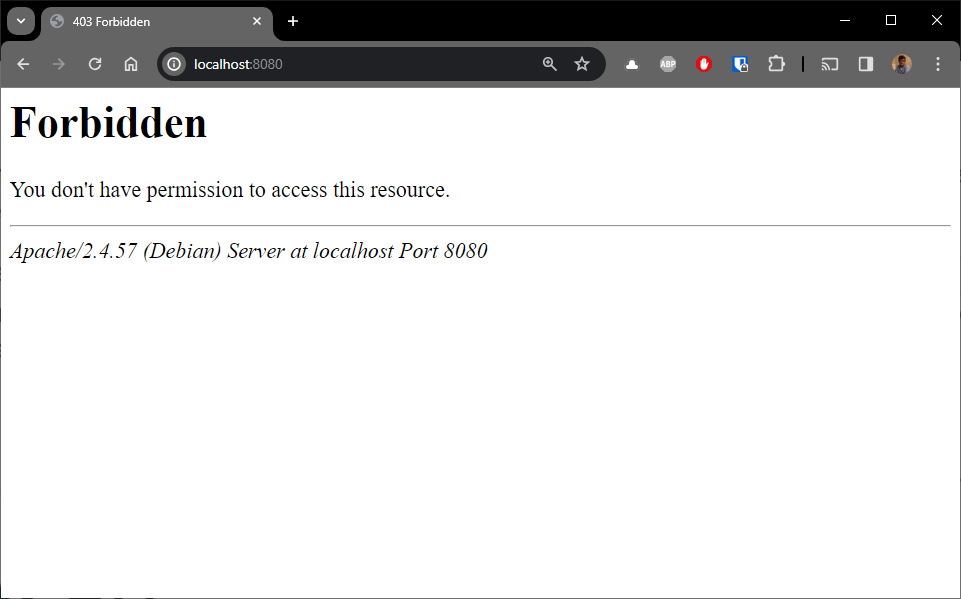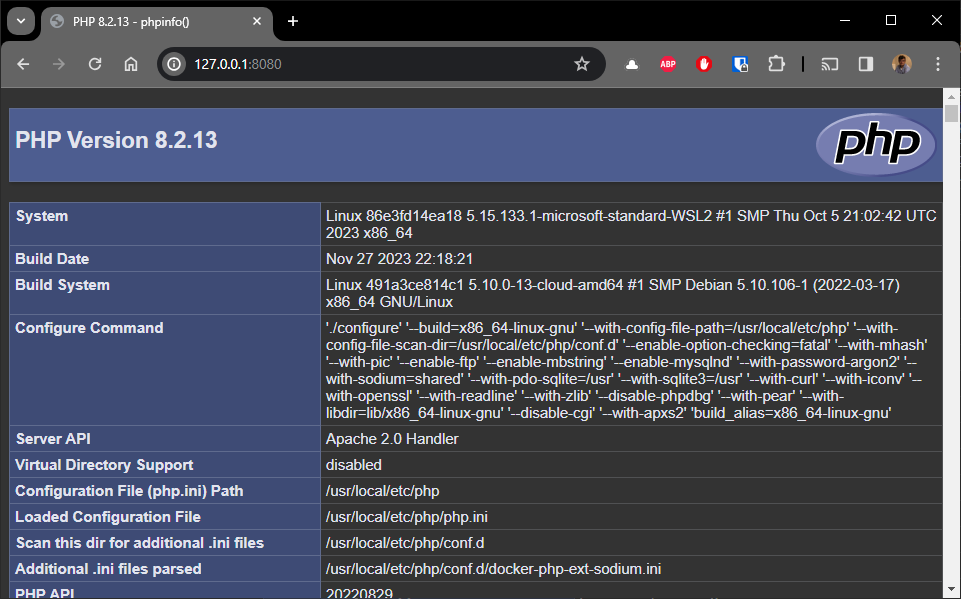Docker init now supports PHP

But what a happy and strange coincidence. In its new version (4.26) released yesterday (on my birthday), Docker adds support for PHP with Apache to its docker init instruction. Let's see how this translates into a practical case.
The official blog post: [https://www.docker.com/blog/docker-desktop-4-26/]
We'll give it a try but spoiler, it's still in a very early stage.
Please start a Linux shell and run mkdir -p /tmp/docker-init && cd $_ to create a folder called docker-init in your Linux temporary folder and jump in it.
Now, in your console, just run docker init and follow the wizard.
❯ docker init
Welcome to the Docker Init CLI!
This utility will walk you through creating the following files with sensible defaults for your project:
- .dockerignore
- Dockerfile
- compose.yaml
- README.Docker.md
Let's get started!
? What application platform does your project use? [Use arrows to move, type to filter]
Go - suitable for a Go server application
Python - suitable for a Python server application
Node - suitable for a Node server application
Rust - suitable for a Rust server application
ASP.NET Core - suitable for an ASP.NET Core application
> PHP with Apache - suitable for a PHP web application
Other - general purpose starting point for containerizing your application
Don't see something you need? Let us know!
Quit
Make sure to select PHP with Apache - suitable for a PHP web application.
For the next questions:
What version of PHP do you want to use?, please enter f.i.8.2,What's the relative directory for your app?, just press enter to select the current directory,What local port do you want to us to access your server?, just press enter to use the proposed port number or f.i. enter8080.
? What application platform does your project use? PHP with Apache
? What version of PHP do you want to use? 8.2
? What's the relative directory (with a leading .) for your app?
? What local port do you want to use to access your server? 8080
CREATED: .dockerignore
CREATED: Dockerfile
CREATED: compose.yaml
CREATED: README.Docker.md
✔ Your Docker files are ready!
Take a moment to review them and tailor them to your application.
If your application requires specific PHP extensions, you can follow the instructions in the Dockerfile to add them.
When you're ready, start your application by running: docker compose up --build
Your application will be available at http://localhost:8080
Consult README.Docker.md for more information about using the generated files.
The wizard is quite straight-forward but, then, we got four files.
Two are really important right now: compose.yaml and Dockerfile.
compose.yaml
By opening compose.yaml with Visual Studio Code, you'll see a lot of comments.
By default, everything is commented except:
services:
server:
build:
context: .
ports:
- 8080:80
Ok, that just means that we'll not use a standard, pre-existing, Docker image but we'll build yours and the definition of that image is located in the current folder (context: .). The definition of your Docker image has to be written in the, standard, Dockerfile.
The second thing we see here is the port number we've chosen. The Docker container will be published on the port 8080.
Dockerfile
Here too, docker init has created a file with a lot of comments. If we remove them, here is the non-commented lines:
FROM php:8.2-apache
RUN mv "$PHP_INI_DIR/php.ini-production" "$PHP_INI_DIR/php.ini"
COPY . /var/www/html
USER www-data
There is a bug in the release 4.26, the COPY statement has to be COPY . /var/www/html (i.e. we need to specify the source folder .). I've created an issue on the Docker repository (https://github.com/docker/cli/issues/4702)
Please update the file Dockerfile and change the line COPY /var/www/html to COPY . /var/www/html
So, we can see we'll use the php:8.2-apache image (since we've asked for PHP 8.2), we'll copy the content of your current folder (.) to the /var/www/html folder inside the Docker image, we'll also use the php.ini file for production and will switch the current Linux user used inside the container to www-data.
Run the container
Ok, nothing really difficult until now. We'll create the image by running docker compose up --build.
Once built, we can surf to http://localhost:8080 and ... ouch.

And this is totally normal. Remember, your current folder only contains actually the four files created by docker init.
Please create the index.php file with this content:
<?php
phpinfo();
Go back to your console, press CTRL-C to stop the first container and run docker compose up --detach --build this time (so the console won't be blocked and the container stay running in background).

Enter in the container
We'll start an interactive shell in the container. We just need to know how the container is named.
Back to the compose.yaml file, we can retrieve the name of the container; it's ne name of the service: server in this case.
services:
server:
[...]
To run an interactive shell, please run the following command:
❯ docker compose exec server /bin/bash
www-data@86e3fd14ea18:~/html$
As expected, you're now inside the container. You can display the list of files by running ls -alh
www-data@86e3fd14ea18:~/html$ ls -alh
total 20K
drwxrwxrwt 1 www-data www-data 4.0K Dec 7 17:52 .
drwxr-xr-x 1 root root 4.0K Nov 21 17:46 ..
-rw-r--r-- 1 root root 742 Dec 7 17:34 README.Docker.md
-rw-r--r-- 1 root root 17 Dec 7 17:49 index.php
So, even if your current folder, on your machine, contains now five files, only README.Docker.md and index.php are present. Why not the other files?
.dockerignore
On your machine, we've thus five files:
❯ ls -alh
total 36K
drwxr-xr-x 2 christophe christophe 4.0K Dec 7 17:59 .
drwxrwxrwt 32 root root 12K Dec 7 17:59 ..
-rw-r--r-- 1 christophe christophe 646 Dec 7 17:34 .dockerignore
-rw-r--r-- 1 christophe christophe 2.3K Dec 7 17:03 Dockerfile
-rw-r--r-- 1 christophe christophe 742 Dec 7 17:34 README.Docker.md
-rw-r--r-- 1 christophe christophe 1.7K Dec 7 17:34 compose.yaml
-rw-r--r-- 1 christophe christophe 17 Dec 7 17:49 index.php
And only README.Docker.md and index.php have been copied into the container.
The reason is: the other files have been ignored because they have been mentioned in the .dockerignore file.
# Include any files or directories that you don't want to be copied to your
# container here (e.g., local build artifacts, temporary files, etc.).
#
# For more help, visit the .dockerignore file reference guide at
# https://docs.docker.com/go/build-context-dockerignore/
**/.classpath
**/.dockerignore
**/.env
**/.git
**/.gitignore
**/.project
**/.settings
**/.toolstarget
**/.vs
**/.vscode
**/.next
**/.cache
**/*.*proj.user
**/*.dbmdl
**/*.jfm
**/charts
**/docker-compose*
**/compose*
!**/composer.json
!**/composer.lock
**/Dockerfile*
**/node_modules
**/npm-debug.log
**/obj
**/secrets.dev.yaml
**/values.dev.yaml
**/vendor
LICENSE
README.md
We have reached the end of this article. We've used the docker init instruction to create the bare essentials needed to run a PHP script in an Apache container.
In the next months, I'll keep an eye on how docker init will evolve concerning PHP.